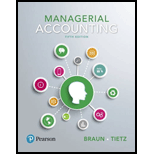
Concept explainers
(Learning Objective 1) Cost distortion is more likely to occur when
- a. departments incur different types of
overhead and the products or jobs use the departments to a different extent. - b. a company manufactures one type of product.
- c. all products require the same amount and type of processing activities.
- d. a company uses departmental overhead rates rather than a single plantwide overhead rate.
To identify: The situation in which cost distortion is more likely to occur
Answer to Problem 1QC
Option a. Cost distortion is more likely to occur when departments incur different types of overhead and the products or jobs use the department to a different extent.
Explanation of Solution
Cost distortion occurs when some products or jobs are overcosted while others are undercosted under simple allocation system. And this occurs because department incur different types of overhead and the products or jobs use the department resources in different quantities.
a.
Departments incur different types of overhead and the products or jobs use the department to a different extent: This option is correct because cost distortion is the result of different types of overheads incurred by various departments.
b.
A company manufactures one type of product: This is an incorrect option as the cost distortion does not occur when there is a single product manufactured by the entity.
c.
All products require the same amount and type of processing activities: Cost distortion will not take place if the amounts of all products are same and type of processing activities is also same. Hence, the choice is incorrect.
d.
A company uses departmental overhead rates rather than a single plantwide overhead rate: This option is incorrect as the use of departmental overhead rate in the place of the single plantwide overhead rate will not distort the cost in any manner.
Want to see more full solutions like this?
Chapter 4 Solutions
Managerial Accounting (5th Edition)
- In the table below, choose the financial instrument to list on the left side that best explains the example on the right side. Types of financial instrument to select from: financial asset, financial liability, equity, compound instrument, basic option, swap, forward, future, warrant, put option, or call option. Type of financial instrument Example A company contracts with an investment bank to pay the bank prime rate + 1% interest on $25 million of debt in exchange for receiving 5% from the bank. Company Abacus issues $10 million debentures with warrants to purchase shares for $10/share within 8 years. A company contracts to sell 100 barrels of oil at $110/barrel in March on the Chicago Mercantile Exchange. Note payable A company purchases the right but not the obligation to purchase 5,000 shares in another company at $15 each over a 12-year period. Company X contracts to buy 1,000 oz of silver at $40/oz on March 15,…arrow_forwardGeneral Accountingarrow_forwardI am trying to find the accurate solution to this financial accounting problem with the correct explanation.arrow_forward
- Can you solve this financial accounting problem with appropriate steps and explanations?arrow_forwardGeneral Accountingarrow_forwardOn August 15, 2026, Tropical Breeze Company issued 80,000 options on the shares of Sunshine Corporation. Each option gives the option holder the right to buy one share of Sunshine Corporation at $70 per share until March 16, 2027. Tropical Breeze received $800,000 for issuing these options. At the company's year-end of December 31, 2026, the options contracts traded on the Montreal Exchange at $9.50 per contract. On March 16, 2027, Sunshine Corporation shares closed at $63 per share, so none of the options was exercised. Required Record the journal entries related to these call options.arrow_forward
- Can you help me solve this financial accounting question using valid financial accounting techniques?arrow_forwardI need the correct answer to this financial accounting problem using the standard accounting approach.arrow_forwardPlease provide the solution to this financial accounting question using proper accounting principles.arrow_forward
- Can you explain the correct approach to solve this financial accounting question?arrow_forwardI need help with this financial accounting question using the proper financial approach.arrow_forwardOcean Corp. has a single class of shares. As its year ended December 31, 2025, the company had 5,000,000 shares issued and outstanding. On the stock exchange, these shares were trading at around $7. In the company's accounts, these shares had a value of $50,000,000. The equity accounts also show $650,000 of contributed surplus from previous repurchases of shares. On January 15, 2026, Ocean repurchased and cancelled 250,000 shares at a cost of $7 per share. Later in the year, on August 20, the company repurchased and cancelled a further 475,000 shares at a cost of $14 per share. Required Record the journal entries for the two share transactions in 2026.arrow_forward
 Cornerstones of Cost Management (Cornerstones Ser...AccountingISBN:9781305970663Author:Don R. Hansen, Maryanne M. MowenPublisher:Cengage LearningPrinciples of Accounting Volume 2AccountingISBN:9781947172609Author:OpenStaxPublisher:OpenStax College
Cornerstones of Cost Management (Cornerstones Ser...AccountingISBN:9781305970663Author:Don R. Hansen, Maryanne M. MowenPublisher:Cengage LearningPrinciples of Accounting Volume 2AccountingISBN:9781947172609Author:OpenStaxPublisher:OpenStax College Managerial Accounting: The Cornerstone of Busines...AccountingISBN:9781337115773Author:Maryanne M. Mowen, Don R. Hansen, Dan L. HeitgerPublisher:Cengage Learning
Managerial Accounting: The Cornerstone of Busines...AccountingISBN:9781337115773Author:Maryanne M. Mowen, Don R. Hansen, Dan L. HeitgerPublisher:Cengage Learning Managerial AccountingAccountingISBN:9781337912020Author:Carl Warren, Ph.d. Cma William B. TaylerPublisher:South-Western College Pub
Managerial AccountingAccountingISBN:9781337912020Author:Carl Warren, Ph.d. Cma William B. TaylerPublisher:South-Western College Pub Financial And Managerial AccountingAccountingISBN:9781337902663Author:WARREN, Carl S.Publisher:Cengage Learning,
Financial And Managerial AccountingAccountingISBN:9781337902663Author:WARREN, Carl S.Publisher:Cengage Learning, Financial & Managerial AccountingAccountingISBN:9781285866307Author:Carl Warren, James M. Reeve, Jonathan DuchacPublisher:Cengage Learning
Financial & Managerial AccountingAccountingISBN:9781285866307Author:Carl Warren, James M. Reeve, Jonathan DuchacPublisher:Cengage Learning





